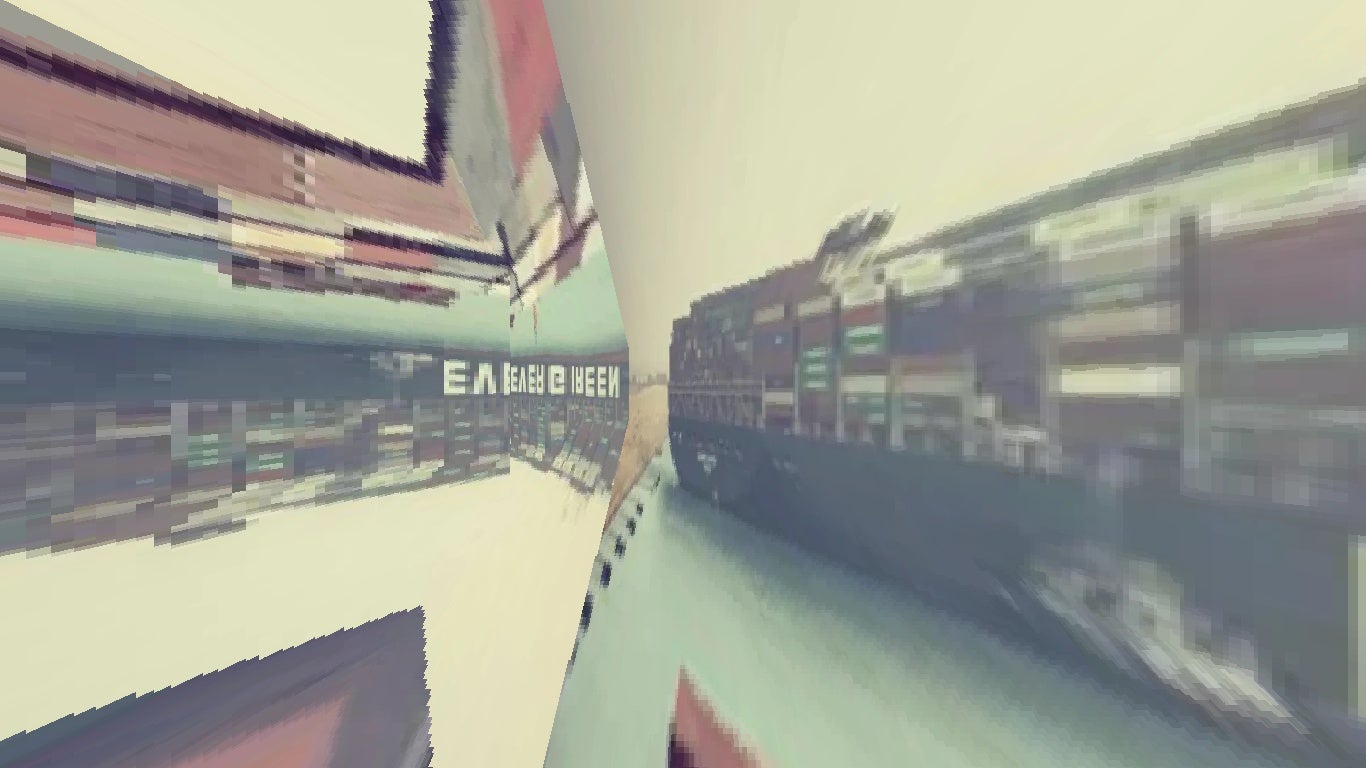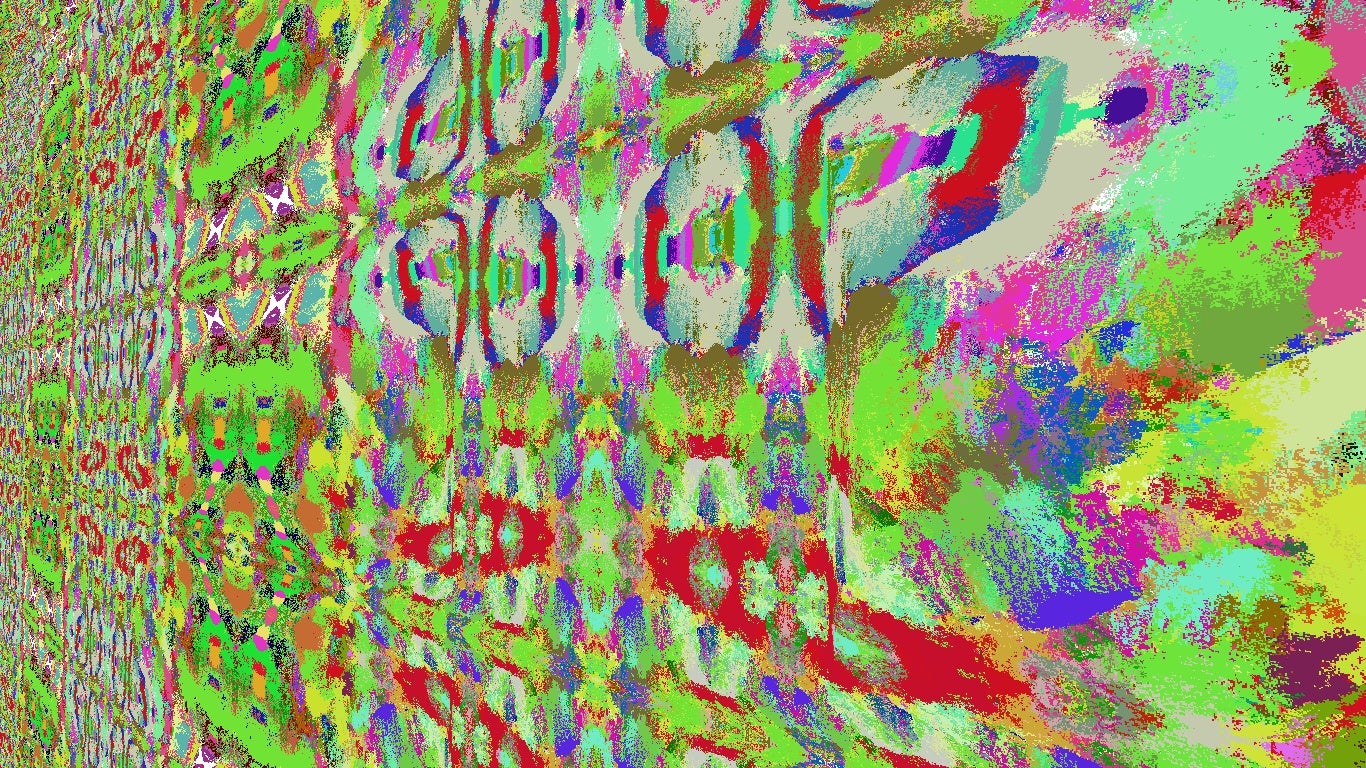The reference in the title of Ian Maclarty’s Catacombs of Solaris is not unearned. The game initially seems to drop you into a fairly standard 3D dungeon crawler space, albeit with walls covered in bands or mosaics of bright colours. Every time you stop to turn your head or decide which branching path to take, though, the space shifts around you in an enveloping optical illusion that draws attention to how the human eye is always tricking us into thinking a flat screen is a 3D space to move around. It can also produce some stunning visual art. Unpredictability has had its place in artistic software for a while, even though, at the professional level of Photoshop, for example, it’s generally seen as undesirable. To return to the Solaris metaphor, for many people, using a piece of software like Photoshop is interfacing with a familiar intelligence in a shared language. The tools are specific and can be tweaked down to the minutest behaviours. It’s daunting to the untrained, but obvious to anyone who uses it long enough. Art software that goes against these formal traits, introducing elements of unpredictability or randomness, and which doesn’t have a straightforward (if technical) way of describing and tweaking every action, often gets written off as unprofessional, limited in use, and probably for kids. However, I think they have their own important uses. Craig Hickman, the creator of Kid Pix, for example, explains in a brief history of the tool, that he developed the software to offer a friendly and non-frustrating way to use the computer for his son. Importantly, it should be “surprising and visually unusual” rather than trying to copy traditional art tools. This meant including a variety of clip art stamps, “wacky brushes,” and flashy visual effects for changing and erasing your work, making the most of what the computer had to offer. These new aspects invited low-stakes play and experimentation, meeting Hickman’s goal that “adults should get a kick out of using it too.” This ethos went on to influence other creative software of the 1990s, like Flying Colors, which offers additional unusual features and opportunities for experimentation, and even contemporary work like Nathalie Lawhead’s playful Electric Zine Maker. The design of these pieces of software highlight the opacity and strangeness of interacting with computers, and offer an inviting context where casual experimentation and play are encouraged, and you don’t have to know exactly what you want or how to do it to get started. The process of exploration itself can lead to figuring that out. Even though it’s more about exploring a space than making your mark on a canvas, playing Catacombs of Solaris feels the same way to me. When I first played it, I wasn’t sure what was going on, since I was just charging straight forward without pausing to look around, a behaviour I’d probably learned from more typical videogames. When I paused, turned, and started to move again, it felt like my perception completely shifted, but it was the space around me. Now, the appearance of the catacombs at the moment I stopped had been applied to the patterns on the walls. By gradually feeling out the quirks and rules of how the game space changed in response to my own movements through it, I began to get a sense of how the catacombs were attempting to accommodate me, and work towards my own idea of an eye-meltingly beautiful space. The Catacombs of Solaris was originally released in a free version on Itch.io in 2016, and MacLarty recently decided to re-release it as The Catacombs of Solaris Revisited, which you can now get for $12 on both Itch.io and Steam. Part of the reason he decided to re-release the game was due to another kind of unpredictability: some people were understandably a bit dubious about downloading and running a mysterious .exe file on their computers. However, there were also other motivations for him to revisit the project. MacLarty describes working on the project as creating a pleasant sort of “curiosity and tinkering” head space, since the game focuses almost entirely on visual transformations. He also wanted to make available a variety of new features he had added for certain events. The ability to import images to use as the wall textures for the catacombs can also produce some surreal and/or hilarious results. MacLarty says he spent a few weeks at the beginning of the year refining these additional features and creating the menu screen for the new version, to try and keep the project low-stress and in the spirit of the original rather than feeling pressured to make something bigger and better. In the almost five years between the original release of Catacombs of Solaris and the Revisited version, the game has had a unique impact in the indie community, especially for a game with no music, no levels, no other characters, no story, and no goals (beyond, of course, finding your favourite room in the near-infinite catacombs). It’s such an intriguing game that it’s been exhibited at several events and festivals, sometimes with alternate rule sets. I got in touch with Nico Disseldorp of the game studio House House, who was involved in developing the idea for Competitive Catacombs of Solaris, as well as Holly Gramazio, who judged one of the competitions. Disseldorp says that the competitive version of Catacombs of Solaris emerged quite organically from the experimental games scene in Melbourne. He was watching another person play Catacombs of Solaris at an event, and started giving them prompts, initially as a sort of joke. What seemed like a silly or impossible task turned out to be surprisingly compelling. “If you have a particular image in mind,” he said, “you can generally find it in the catacombs.” Disseldorp then worked with local venue Bar SK to run a round of Competitive Catacombs of Solaris as a big event, presenting it as if it were an existing esport, or “artsport.” The tournament consisted of 90-second rounds where two competitors would attempt to find the image implied by the prompt in the catacombs. Judges were there to evaluate a winner or, failing that, decide which competitor’s work could get the loudest cheers. Everyone’s name was written on a coaster stuck to the wall, and after losing two rounds they would be removed from consideration in the tournament. While a straightforward concept, Disseldorp thinks the specifics of how Catacombs of Solaris works means the competition offers plenty of strategy and depth. There’s moments of high drama as players search the walls for just the right colour, or an image comes together with seconds left. The process competitors go through to find their image is, according to Disseldorp, “like finding a needle in a haystack, and then focusing on that needle until it becomes a haystack.” Competitive Catacombs of Solaris is easy enough to replicate on your own, all you need are two people running the game, a timer, a list of prompts, and a judge to oversee the competition. I asked Holly Gramazio, a game designer and curator of playful work, what her experience was like as a Competitive Catacombs of Solaris judge. She notes that a good prompt is vital, whether it’s as concrete as “a tiger” or as abstract as “despair.” Judging should be handled with a spirit of seriousness but also awareness of the slight absurdity of playing the game competitively. Generally, she observed, there was an obvious winner, but if you could make a case for it, as a judge, it was okay to go against what might seem like an obvious choice to the audience. She also recommended complimenting both players, not just for sportsmanship’s sake, but to build some tension leading up to your decision. As an “artsport,” it’s something that it’s impossible to be completely scientific about, but making a case for one competitor over the other can be an interesting process in itself. If you’re all by yourself or just not feeling particularly competitive, though, Catacombs of Solaris also ultimately works well as a contemplative and creative single-player experience. My advice is to put on some of your own tunes and play around with the winding, morphing crypts, treating it as a chance to collaborate with some sort of alien environment to make some dazzling visuals. And if you opt to try some of the mutators that come with the paid version, MacLarty’s favourite to use is a combination of OIL and COR (short for Corrode), which he says creates a mesmerising sand-art like effect.

